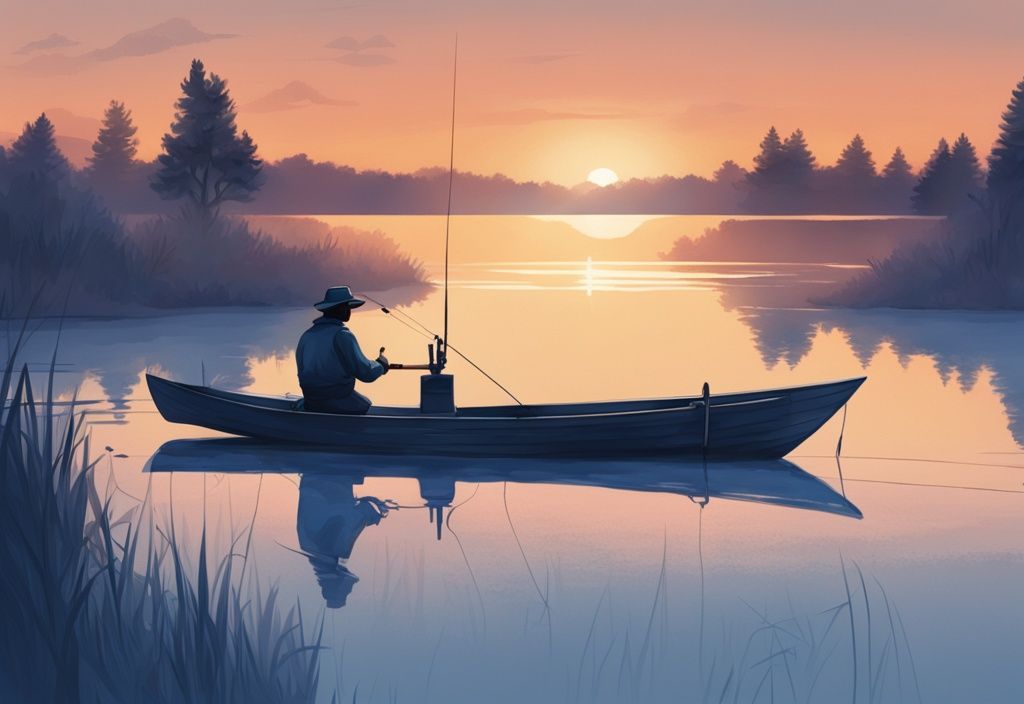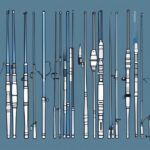“Ever sat on the water’s edge, just waiting for a bite that never comes? Believe it or not, the time of day you’re casting your line can mean the difference between a fishing tale and fishing fail. As a seasoned angler myself, I’ve spent more hours fishing than most people do sleeping! By trial, error and some fishy hunches, I’ve figured out the answer to a question that’s been bugging anglers worldwide: what time of day is best for fishing?
This piece dives into some tried-and-true wisdom about optimal fishing times. Whether it’s the tranquility of early morning or the bustling activity of late afternoon, different times offer unique advantages (and a few challenges). It’s not just about the hour hand either—we’re talking lunar cycles, weather patterns, and those myriad environmental factors that fish seem to rely on.
So sit back, fellow fishing enthusiasts. Get ready to discover how planning your fishing trips with the sun, moon, and yes – even the clouds, in mind, can lead to a bountiful haul. It’s high time we crank up your fishing game!”
Understanding the Best Times of Day for Fishing
When it comes to maximizing your fishing success, timing can be everything. Let’s delve into how different parts of the day can impact your fishing experience, helping you decide what time of day is best for fishing.
Exploring Early Morning Fishing Advantages
The early morning hours are a magical time on the water. Right after sunrise, the fish are bustling with activity, spurred on by the cooler temperatures. It’s as if they’re enjoying their morning coffee, making them more likely to bite. Unlike the blinding midday sun, the early morning light is softer and much less likely to spook fish.
Moreover, you’ll find fewer anglers out at dawn. You know what that means? Less competition! The serene, less crowded waters during these hours significantly boost your chances of landing a good catch. You can almost feel the excitement in the air as your line dips into the calm, early morning water.
Midday Fishing: Why it Might Not Be the Best Choice
Now, let’s talk about the challenges of midday fishing. As the sun climbs higher, the surface water heats up, sending fish scurrying to deeper, cooler spots. This mass exodus makes finding and catching fish a Herculean task. The noon sun is so relentless it could have you feeling like a fish out of water yourself!
Fish tend to become lethargic under these harsh conditions, and visibility is at its peak, making them more cautious. Simply put, midday fishing can be tough. For those seeking to improve their fishing gear, checking out the best 5 saltwater spinning reels might offer a significant advantage. It’s a bit like going on a treasure hunt but with the map half-burned.
Benefits of Fishing in the Late Afternoon and Evening
As the day begins its graceful descent into late afternoon and evening, the conditions shift back in your favor. The cooling temperatures invite fish to once again explore the shallower waters. It’s as if the fish have reset the stage, ready for an encore of their morning performance.
The fading sunlight also works in your favor, encouraging fish to be more active. Not to mention, there’s typically less crowding from other anglers, giving you more room to work your magic. The tranquility of these hours not only elevates your chances of a successful catch but also offers a peaceful, rewarding end to your day.
From sunrise to sunset, understanding what time of day is best for fishing can make all the difference. Whether you’re a dawn patroller, a midday warrior, or an evening angler, each time slot has its own unique benefits and challenges. So grab your rod and let the rhythms of the day guide you to your next big catch!
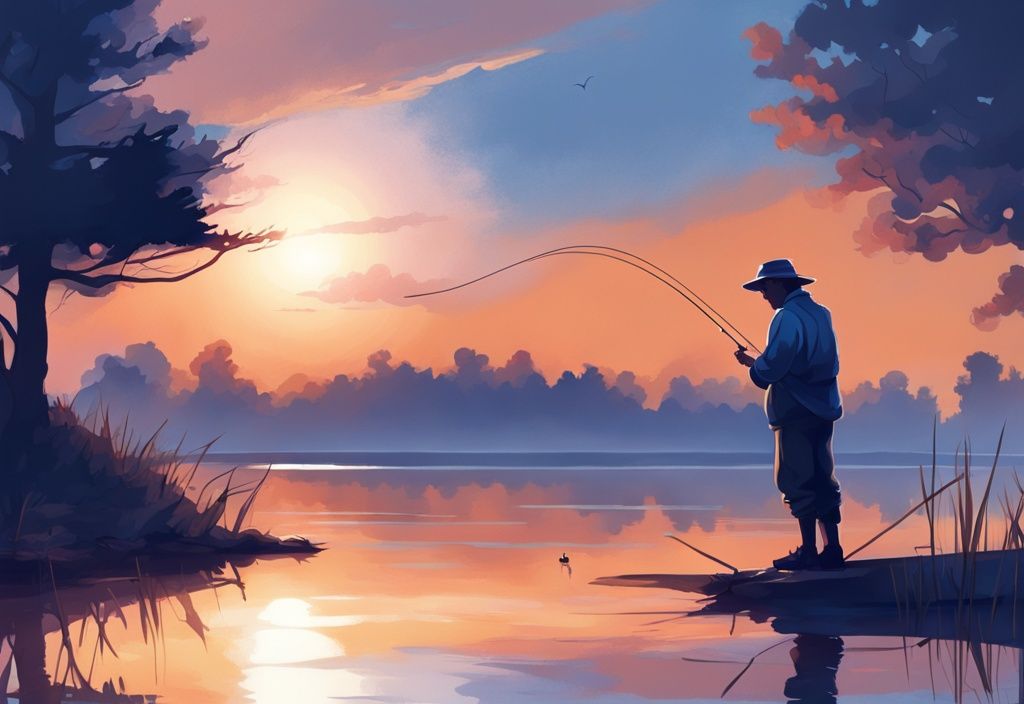
How Weather Conditions Influence Optimal Fishing Times
Impact of Light Rain and Windy Conditions on Fishing
Light rain can significantly enhance fishing conditions, creating an environment where fish are more active and willing to bite. The rain brings insects and other small creatures into the water, becoming an immediate food source that can trigger a feeding frenzy among fish. Overcast skies that often accompany light rain serve to further stimulate fish activity, as they reduce light penetration and encourage fish to forage more actively near the surface.
Windy conditions can also play a crucial role in determining where fish are located. Wind can push water and surface food to one side of a lake or river, concentrating fish in these areas as they follow the food supply. Anglers can take advantage of these dynamics by positioning themselves along the windward shores where fish are likely to be found in higher numbers.
What Happens to Fishing During Storms and Cold Fronts?
Storms and cold fronts present unique challenges and opportunities for anglers. In the period leading up to a storm or a cold front, fish tend to feed more aggressively, sensing the atmospheric changes and the impending shift in weather. This pre-storm feeding window can be one of the most productive fishing times.
However, during and after a cold front, fish activity often declines. Rapid drops in temperature and changes in barometric pressure can make fish lethargic and less likely to bite. Adverse weather conditions like heavy storms can also make fishing difficult and unsafe, requiring anglers to adapt their strategies and possibly reschedule their fishing trips for more favorable conditions.
Fishing in Warm Fronts: A Game Changer?
Warm fronts can significantly enhance fishing conditions by raising surface water temperatures and stimulating fish activity. As the water warms, the metabolic rates of fish increase, making them more energetic and more likely to feed aggressively. This heightened activity can lead to more frequent bites and a higher success rate for anglers.
During warm fronts, fish are often found in shallower waters where the sun has warmed the surface. This increased activity and feeding behavior can make fishing during a warm front particularly rewarding. Understanding how warm weather influences fish behavior can help anglers decide what time of day is best for fishing and improve their overall fishing experience. Additionally, factors like barometric pressure also play a significant role in fish behavior and feeding patterns, making it essential for anglers to stay informed about these atmospheric conditions. For more insights on how barometric pressure affects fish behavior, check out this informative article: https://inthespread.com/blog/weather-patterns-fishing-how-barometric-pressure-affects-fish-behavior-346.
Important Environmental Factors That Affect Fishing Times
The times when you hit the water can make or break your fishing day. Let’s dive into some environmental factors that play a key role in determining what time of day is best for fishing.
How Does the Lunar Cycle Affect Fishing?
Ah, the moon! It’s not just for romantics and werewolves. The lunar cycle has a profound influence on fishing, and knowing when to fish during the full and new moon can significantly boost your chances.
During a full moon, the gravitational pull alters the tidal patterns. More light means fish are more visible and aggressive, darting towards the illuminated water surface. On the flip side, a new moon creates an inky darkness, encouraging fish to be more active as they hunt down their prey. It’s these periods that many seasoned anglers, including myself, mark on their calendars, aligning their trips with the moon phases to maximize their success.
Experienced anglers like to capitalize on these shifts, planning their fishing adventures to coincide with the peaks in fish activity brought about by the lunar changes. By doing so, you’re not just hoping to catch a fish; you’re making an informed decision based on nature’s rhythms.
The Influence of Seasonal Changes on Fishing Times
Seasonal changes are the fish whisperers letting you know the optimal time of the day to cast that line. When the sun starts its climb in the sky during warmer months, the early mornings and late evenings become prime fishing windows. Why? The cooler temperatures during these times seem to invite fish to the shallows for their breakfast and dinner before diving back into cooler depths to escape the midday heat.
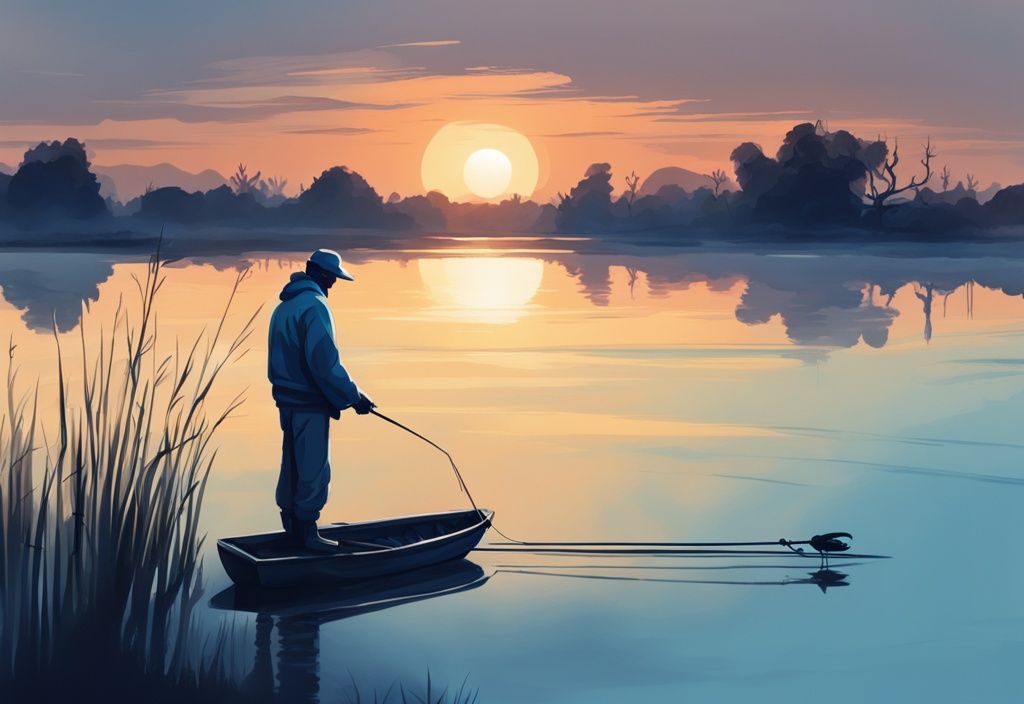
And let me tell you, fishing during the hottest part of the day in the summer? Forget about it. Fish are smart—they retreat to deeper, cooler waters where they don’t have to deal with the surface temperature. That leaves us anglers with empty nets if we don’t adapt.
When winter rolls around, the game changes again. Fish become less active; their metabolisms slow down as they seek out the slightly warmer waters available at midday. This means your morning and evening fishing escapades might not be as fruitful. Instead, aiming for mid-afternoon can make all the difference, giving you a better shot at a catch.
So, keep these seasonal shifts in your back pocket. Adapting your strategies according to the weather and water temperature will not only make your trips more enjoyable but also more rewarding.
How to Boost Your Fishing Experience Using Forecasts and Calendars
Decoding Daily Fishing Forecasts for Best Times
Ah, there’s nothing quite like the anticipation before a fishing trip. Now, if you’re serious about fishing and really want to maximize your chances of success, understanding when to cast your line can make all the difference. By using daily fishing forecasts, you can pinpoint what time of day is best for fishing. These forecasts break down the nitty-gritty details: time of day, weather conditions, and moon phases.
Imagine this: early morning, the sun just peeking over the horizon, with cool, crisp air enhancing fish activity. Late evening also holds similar magic with its cooler temperatures. Weather forecasts often predict light rain or gusts of wind, which, believe it or not, can stir up more fish movement. Plus, moon phases—full moons and new moons—are crucial since fish tend to feed more aggressively. So, why not plan your trips around these peak activity windows? It’s almost like having the fish whispering their schedules right into your ear.
Why Consult Local Anglers for Optimal Fishing Times?
Let’s talk local knowledge. There’s a reason old-timers and seasoned local anglers are revered in the fishing community. These folks have accumulated a treasure trove of wisdom about what time of day is best for fishing in their specific spots. They know the local waters like the back of their hands, understanding fish behavior down to a T.
Consulting them can give you a leg up. Think of it as having a personal coach who advises on where to fish and what times are golden. Local anglers can clue you in on the best bait and tackle, refined through years of trial and error. They know the subtle hints—like a specific temperature that triggers a biting frenzy or a particular season when a species is more active. Tapping into their experience is like unlocking the secrets of the lake, river, or ocean you’ll be fishing in. It’s simple: listen to them, and your fishing outcomes will skyrocket. Whether you’re a weekend warrior or a seasoned pro, combining daily forecasts with seasoned local advice can transform your fishing game. For those looking to enhance their fishing trips, exploring the 10 best fishing sling packs can offer you the convenience and efficiency you need. Every trip becomes an adventure, full of excitement and increased chances of landing that dream catch. Happy fishing!
Concluding Thoughts: Fishing at the Right Time
The question of what time of day is best for fishing isn’t straightforward but rather influenced by a variety of interconnected factors. Each of these elements—from the time of day to weather conditions, lunar cycles, and seasonal shifts—plays a crucial role in determining the productivity of a fishing expedition.
First, understanding the benefits of early morning fishing and late afternoon or evening fishing highlights the natural rhythms that make fish more active during these times.
Fish tend to be more vigorous in cooler waters, which explains their heightened activity after sunrise and before sunset. The early morning sun is softer and less intense, providing a conducive environment for fish that shy away from bright light. Furthermore, decreased fishing pressure due to fewer anglers being out during these hours can significantly increase the chances of a successful catch.
Midday often proves to be less fruitful, not necessarily because fish disappear, but because their behavior changes in response to increased water temperatures and bright sunlight.
Fish tend to retreat to deeper, cooler regions and become less active, making midday fishing more challenging and less productive. By understanding these behavioral shifts, anglers can adjust their strategies accordingly, focusing efforts during early and late periods of the day.
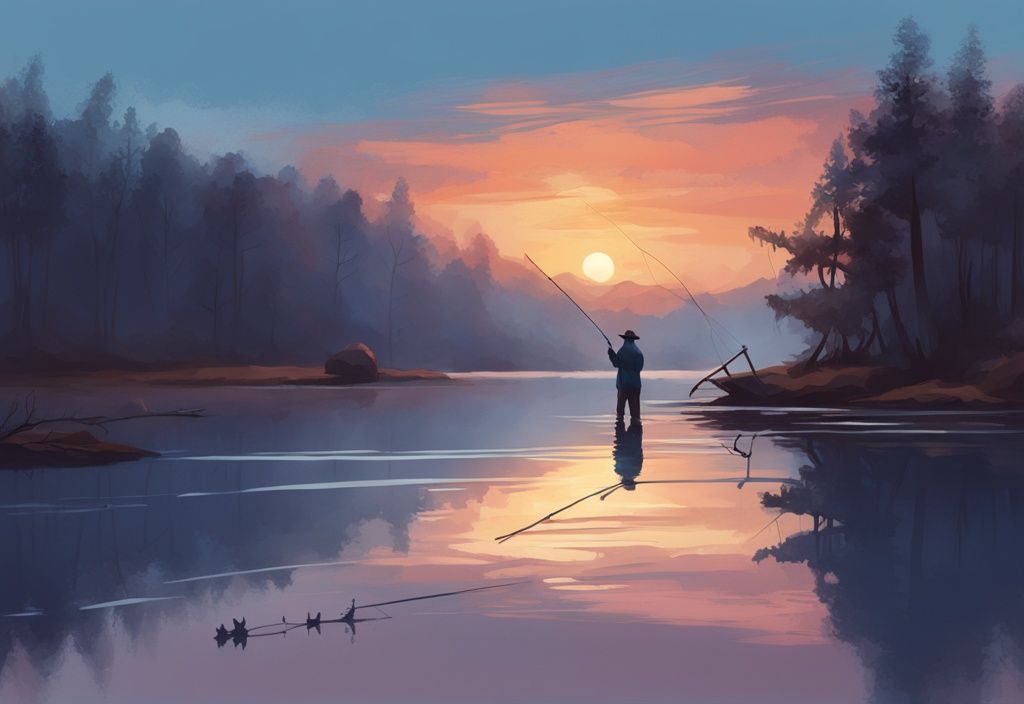
Weather conditions also play a pivotal role.
Light rain can enrich the water with nutrients and bait, enhancing fish activity, while windy conditions can bring fish closer to certain shores. Storms and cold fronts, on the other hand, usually signal a decrease in fish activity as they tend to seek shelter and become less inclined to feed. Warm fronts can act contrary to cold fronts by stimulating fish activity, making them more aggressive feeders due to the increased water temperatures.
Moreover, the lunar cycle is an often overlooked yet significant factor.
Fish demonstrate increased activity during full moon and new moon phases due to the gravitational pull, which influences their feeding and movement patterns. Aligning fishing trips with these lunar cycles can result in more productive days on the water.
Seasonal changes further compound these influences.
In warmer months, early morning and late evening fishing become optimal given the cooler temperatures and increased fish activity during these times. Conversely, in colder months, these preferred times may shift, requiring anglers to adjust their schedules and techniques accordingly.
Ultimately, combining these varied approaches—leveraging daily fishing forecasts, heeding personal logs, and seeking advice from local anglers—can significantly elevate one’s fishing success.
By understanding and adapting to these multifaceted factors, anglers can position themselves for more rewarding and fruitful fishing experiences.
Frequently Asked Questions
Is Early Morning or Evening Better for Fishing?
Ah, the age-old debate! Both early morning and late evening are prime times for fishing due to increased fish activity and favorable conditions. Imagine the tranquility of dawn, the mist rising off the water as fish start to stir. Evening brings its magic too, with the setting sun casting golden hues across the water. Ultimately, choosing between these times comes down to personal preference and a variety of factors—specific weather patterns and local angler tips on what time of day is best for fishing can make all the difference.
What Effect Does Weather Have on Fishing?
Weather is a game-changer when it comes to fishing, no doubt about it. Light rain? That’s like a dinner bell, washing bait into the water and getting fish excited. But storms and cold fronts? Those can shut things down. Overcast skies and warm fronts create perfect conditions, with fish feeling more confident and active, resulting in better catches. Remember, checking the forecast isn’t just about packing the right gear—it’s about timing your trip for maximum success.
Can Moon Phases Influence Fishing Times?
Oh, absolutely! Moon phases play a significant role in fish behavior. During the full and new moons, fish tend to be more active and hungry, making these phases ideal for fishing. Many anglers swear by planning trips around these lunar events. Think of it as nature’s own schedule for when the fishing can be at its finest.
How Much Do Seasonal Changes Affect Fishing?
Seasons change, and so does the fishing game. Seasonal shifts impact water temperature and fish behavior, guiding when the best fishing times might be. In the warmer months, early morning and late evening are where the action’s at, avoiding the midday heat that can make fish sluggish. It’s all about adapting to the rhythms of nature. You’ll thank yourself later when you feel that satisfying tug on your line during those peak times.
